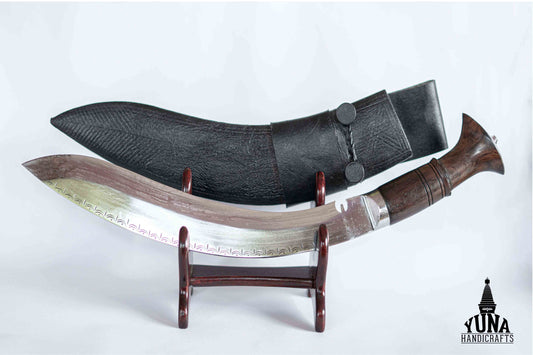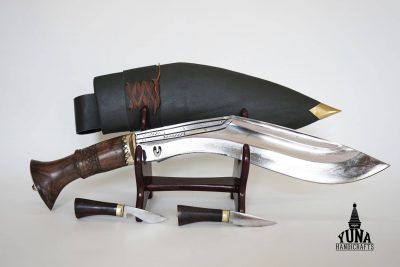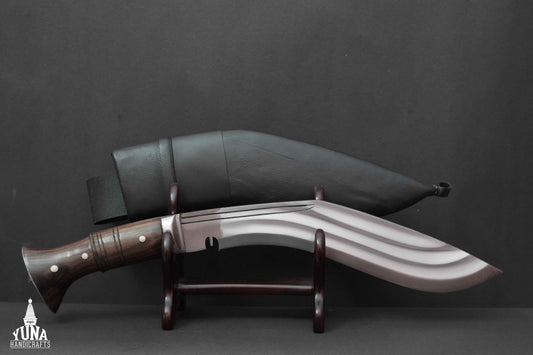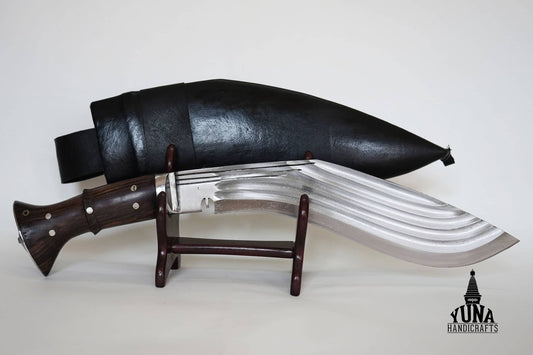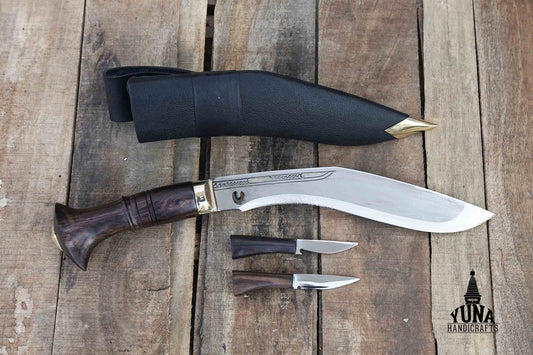
How to sharpen a Kukri?
Let’s explore how you can sharpen a Kukri and things to consider before, during, and after sharpening your Kukri in this guide.
Things Required
Kukri
Whetstone
Chakmak
Steelwool
Prepare First Before Sharpening
Prepare Whetstone
Place the whetstone on water until you see little bubbles. It means that the whetstone is ready for sharpening.
Prepare Kukri
You might want to clean the Kukri blade first with steel wool. This removes unnecessary dents and stains on your Kukri blade. A few rubs will do.
Notice the Grid Line or the Bevel Line
Mark the bevel line with a marker if necessary to pinpoint the edge. Try to maintain the sharpening edge up to this point.
Find the Sharpness You Need
How much sharpening is needed for your blade depends on where and how you use your Kukri. If you do butchering, cutting meat and bones, you should avoid sharpening too much, as this may make the blade last shorter. However, if you want a powerful blade, you can go with sharper blades. Ideally, a sharper blade will last longer and need less frequent sharpening.
Sharpen Kukri with Chakmak Tool
What is a chakmak Kukri sharpener tool?
Most Kukri models come with two tools: a knife sharpener called a chakmak and a small knife called karda. If you don’t want extra sharpness, Chakmak can handle your basic sharpening.
Sharpen with Chakmak
To sharpen with a Chakmak, hold the Kukri handle, pointing the tip down. Then place chakmak at around 45 45-degree angle and use the sharpener to grind it along the way. After you are finished with one side, flip the Kukri blade facing the other side and repeat. The video below clearly demonstrates how you can do so with Chakmak.
YouTube video showing how to use Chakmak to sharpen a Kukri. The grit is the specification of how fine the whetstone can sharpen your blade. Normally, whetstones come with two sides with different grit levels to sharpen your blades. For Kukri blades, you can get the whetstone with coarse 600 grit and then finish with 1000-2000 grit whetstone to refine the edge. We suggest that you try and test different grits to find the one suitable for your unique needs. Lubricate the Kukri and the whetstone regularly. The metal and stone residue can make an uneven scratch on the blade. Uneven angles can make the blade thickness inconsistent and dull the blade. If you want a sharper blade, you use steeper angles, but it also makes the blade thinner and prone to damage. For Kukri, we recommend around a 15-25 degree angle, depending on how sharp you want your blade. You can start with the 600 grit and then finish at 1000 grits to see if the sharpness is up to your needs; if not, then you can try a finer grind. As you sharpen your blade, you can notice a very thin metal layer forming, called burr, appearing on the other side of the edge of the blade. You should remove the burrs by stropping or dragging them across a smooth, fine surface like leather. After sharpening your blade, completely dry it first. Kukris are prone to rusting, and a wet Kukri will rust faster. After your Kukri is dry, you can lubricate the Kukri blade with oil, preferably gun oil, for extended protection for a long period of time. You should use a thin oil coat, as too much oil coat is not preferable when placing the blade inside the leather or wood sheath. We thank you for owning this piece of the Nepali heritage and craftsmanship. This guide is just a direction on how you can sharpen your blade. You can refer to this guide to get started in sharpening your Kukri, and over time, you will surely find the perfect mixture for your own needs.Sharpen Kukri with Whetstone
Choose the Right Whetstone
Things to Consider When Sharpening
Lubricate the Kukri and the Sharpener
Maintain a Consistent Angle
Start Coarse and Finish Fine
Remove the Burr
After Sharpening
Conclusion

